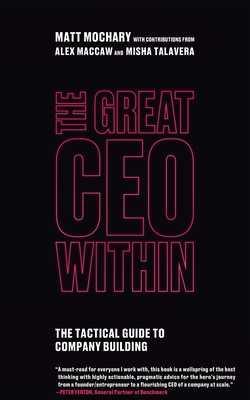Explore the World's Best Ideas
Join today and uncover 100+ curated journeys from 50+ topics. Unlock access to our mobile app with extensive features.
The Great CEO Inside You: Key Takeaways
- You need to learn how to manage yourself before you can manage your business.
- Communicate ideas and proposals in writing during the decision making process.
- If you do it twice, write it down. Documentation is the key to building scalable processes.
- Don’t ignore conflict. Be transparent, give/take feedback often, and be an active listener.
- Be obsessed with learning about your customer. Do so by asking better questions.
214
1.52K reads
The Initial Team
- Find a partner who has complementary skills to yours.
- Give up a large percentage of the company. It’s worth it.
- Do not create a 50/50 partnership. While 50/50 sounds like an ideal, it actually leads to real pain if there is no easy way to break a deadlock.
- Founding teams should never grow beyond six until there is a true product-market fit(PMF).
- PMF is having created a product that customers are finding so much value in that they are willing to both buy it and recommend it later.
- Metrics that show whether PMF has been achieved include: revenue, renewal rates, NPS (net promoter score).
195
1.05K reads
Inbox Zero: Work On Your Top Goals
Inefficient leaders waste a lot of time reaching out about, or responding to, one-off issues in real-time. A much more efficient method is to batch your issues and discuss them all at once.
Check email only twice a day: morning and afternoon.
Schedule two hours each day to work on your Top Goal only. And do this every single work day. Period.
The earlier in the day you schedule this Top Goal time, the better, so as to avoid other issues (and people) from pressing for your attention.
196
862 reads
On-Time and Present
- Do not waste other people’s time. It is disrespectful and counterproductive.
- When you anticipate being late, let the other party know as soon as possible.
- Be present. Be focused on what’s being discussed. Do not check your messages. Phone and computer away.
182
812 reads
Gratitude
- Focus on the positives.
- We perform our best when we are having fun and feeling good about ourselves.
- Say or write down one thing that you’re thankful for each day.
- Be appreciative. Tell people when they’ve done something good.
- Set aside 1 hour a week to be intentionally appreciative. Follow up and outreach.
- Do not feign humility by downplaying the act with statements like “It was nothing, anyone could have done it.” No. The person is trying to make you feel appreciated. Anything other than “thank you” will rob them of their goal.
185
668 reads
Check Your Energy
- If you can spend 75-80% of your time doing things that energize you – magic will occur.
- Audit your time and figure out how much of it is spent on activities that energize you and what activities drain you. Outsource or delegate the things that drain you as much as possible.
187
717 reads
The Four Zones
Zone of incompetence: other people do better than you
Zone of competence: you can do it just fine, but others are just as good as you
Zone of excellence: things you are better at than others. You will want to keep doing these things, but this is dangerous. You need to move away from these things.
Zone of genius: these are the things that you are uniquely good at in the world and that you love to do. This is where you should be driving toward spending most, if not all, of your time.
192
615 reads
Health
- Your physical health is paramount.
- Take care of your mental health. Build a support group.
- Get a therapist, even if you don’t think you need one. You will find it invariably useful.
178
606 reads
Decision Making
If you want the most effective and efficient decision-making process, require that anyone who wants to discuss an issue write it up, along with the desired solution, ahead of time.
Two ways to do this:
The hard way: Write an extraordinarily thorough analysis from the get-go.
The easy way: Write a draft, circulate it to the meeting participants before the meeting, and invite comments and questions.
This method, though time-consuming for the sponsor, yields extraordinarily thoughtful decisions in a very short amount of time.
178
583 reads
Getting Buy-In
- You get buy-in when people feel they are part of the decision and their input matters
- When people are given more influence, they feel more invested.
The Three Methods:
- The manager decides, tells the team, and answers questions.
- The manager creates a straw man (hypothetical answer designed to inspire discussion), shares it with the team, invites feedback, facilitates group discussion, and then determines the final answer.
- The manager invites the team to a meeting with no straw man to discuss the dilemma from scratch. The final decision is made by consensus if possible.
178
502 reads
Issues and Proposed Solutions
- Don’t discuss issues verbally. It is both inefficient and ineffective.
- Instead, require that anyone who presents an Issue at a team meeting do so in writing.
- The write-up should include both a detailed description of the Issue as well as their Proposed Solution. They cannot say “I don’t know.” They must at least present a guess. It must be phrased boldly, in direct terms.
- All issues should be presented at the weekly Team Meeting.
- Allow 5 minutes to discuss each Proposed Solution. If consensus is reached in that time – great. If not, don’t spend more time debating.
178
453 reads
Loudest Voice in the Room: Ensure Fairness In Meetings
- Be aware of who is in the room when you have a group discussion. Know that work titles will influence other people’s answers.
- To avoid influencing other people’s ideas, have people write down their votes or thoughts before you share your perspective.
- Let junior people speak and ask questions first.
178
464 reads
Sloppy Agreements
- Sloppy agreements are when people don’t show up on time, don’t complete the goals that they declare.
- The antidote is Impeccable Agreements. They are 1) precisely defined and 2) fully agreed to (which almost always means written) by all relevant people.
- There must be consequences to breaking agreements.
- If you can’t meet the agreement, then you have an obligation to let other members of the agreement circle know as soon as possible.
175
398 reads
Transparency
- Don’t hide negative information.
- Our imaginations are much more powerful than reality.
- Share all relevant information with your team, both negative and positive. Let them adapt.
175
417 reads
Conflict Resolution
Interpersonal conflict is almost always due to people:
- Not fully sharing their thoughts and feelings
- Not feeling heard
Prove to people that you have heard them by summarizing what you just said back to you until they say “that’s right!” Once you assure them that you’ve heard them, then, and only then, will they be open to what you have to say in response.
176
369 reads
Issue Identification
- Ask each people to pretend that they’re the CEO and answer “What are the most important issues (max 3) for me to solve in the next 90 days?
- Ask people to write down their thoughts about the company when they source their Joy, Excitement, Sadness, Anger and Fear.
178
355 reads
Values And Culture
- You don’t choose your values. You have them.
- Use your values as a guide to who you hire and when you fire.
- Print and distribute your values
- Don’t underestimate the value of FUN as a value.
- Don’t forget to celebrate. Make an effort to publicly acknowledge achievements
- Don’t measure hours. Measure output. However, it’s still key that there is a core period of time when everyone shows up to the office so that collaboration can happen.
- You prevent office politics by never allowing lobbying to be successful.
180
344 reads
Goal Tracking And Responsibility
- Never assign someone an action without them agreeing to it verbally or in writing.
- Encourage people to use their own individual tools for tracking their specific actions. Keep the group goal tracker high level.
Areas of Responsibility:
- When more than one person shares a responsibility, it often does not get done well, or at all.
- One person is assigned to each function in the company. This is the AOR list. Maintain and update it as responsibilities shift.
176
324 reads
Collaboration: OKRs
Every successful large company uses a system of “Objectives and Key Results(OKRs)”.
- Set vision and goals for the company, each dept, and each individual on a regular basis (usually quarterly).
- Communicate that vision and those goals to every team member.
- Tracking and reporting progress towards those goals on a regular timetable – usually weekly.
- Elicit feedback on what’s going right and what needs to be changed.
179
310 reads
Tracking Of OKRs
Target is 3 objectives with 3 key results for each.
The Objective: Where do we want to go? Not necessarily measurable
Key Results: How do we know that we’re getting there? These should be measurable.
- Gather your leadership team and have everyone come to the meeting with their ideas for what the OKRs should be for the quarter.
- Much better to let individuals come up with their own OKRs. They will be more invested.
177
271 reads
Recruiting
- Be efficient, or risk grinding all other processes to a halt.
- Spend as little time as possible with the candidates that you don’t hire (quick evaluation) and as much time as possible with the candidates that you want to and do hire (building a relationship, onboarding/training).
- Be fast. In recruiting, you would make an offer to the candidate “pending reference interviews”.
172
282 reads
Sales: Building Trust With The Customer
- Ask the customer about them.
- Listen actively and reflect back on what they say.
- At the second meeting, show that you remember what they said at the first.
- Be explicit about NOT talking about your company.
- “Before we talk about what we do, I’d like to start by getting to know your situation, to know if we’re even the right solution for you.”.
- Ask for a limited amount of time, so the burden is low:
- “Let’s have a short introductory call for 10 minutes.”
179
294 reads
Sales: Customer Development
- Identify the customer’s specific challenges by asking the right questions.
- You need to understand your customer’s pain before you present your solution.
- Over time, you will want to build an inventory of problem and solution statements for the different kinds of customers and different product features your product serves.
179
277 reads
Sales: Hiring The Sales People
- Don’t hire sales people right away.
- In most cases, salespeople will never be able to sell better than the founders and they won’t be able to sell the product if you are not able to.
- To thrive, salespeople need to have a very clear product offering to sell and a very clear direction on who to sell to.
179
288 reads
Lead Generation: The Three Kinds Of Leads
Seeds : Seeds are generated from word-of-mouth, usually from customer referrals or prior relationships.
Nets : Nets are generated from your marketing, such as events, SEO, white papers, and ad campaigns. They are called Nets because you are going for “quantity over quality”.
Spears : Spears are generated from direct outbound outreach by your Outbound Reps, usually through email outreach or LinkedIn mining. They are called Spears because they are hyper-targeted and you are going for “quality over quantity”.
178
304 reads
Marketing
- The greatest risk is not moving too slow. It’s spreading scarce resources too thin.
- Start by concentrating all of your efforts on the low hanging fruit – the small customer segment that has a particular problem that your product solves 10x better than the competition.
- Only move on to the next customer segment after you have the resources to do so.
178
297 reads
Great CEOs Use These Handy Tips
- You need to document everything.
- Be more interested in learning than in being right.
- You are not making a product. You are solving a customer problem. It is critical that you continually live that customer problem.
- Assign each new team member a buddy with whom they’ll check in each day for fifteen minutes for the first two weeks.
183
319 reads
IDEAS CURATED BY
CURATOR'S NOTE
What to do when you are CEO.
“
Matthew Clark's ideas are part of this journey:
Learn more about business with this collection
How to build trust and respect with team members
How to communicate effectively
How to motivate and inspire others
Related collections
Discover Key Ideas from Books on Similar Topics
12 ideas
Build
Tony Fadell
6 ideas
Masters of Scale
Reid Hoffman, June Cohen, Deron Triff
12 ideas
How to Make Your Goals Achievable
linkedin.com
Read & Learn
20x Faster
without
deepstash
with
deepstash
with
deepstash
Personalized microlearning
—
100+ Learning Journeys
—
Access to 200,000+ ideas
—
Access to the mobile app
—
Unlimited idea saving
—
—
Unlimited history
—
—
Unlimited listening to ideas
—
—
Downloading & offline access
—
—
Supercharge your mind with one idea per day
Enter your email and spend 1 minute every day to learn something new.
I agree to receive email updates

























